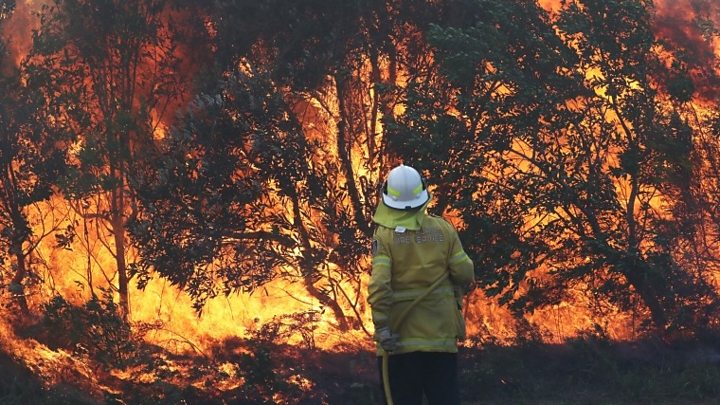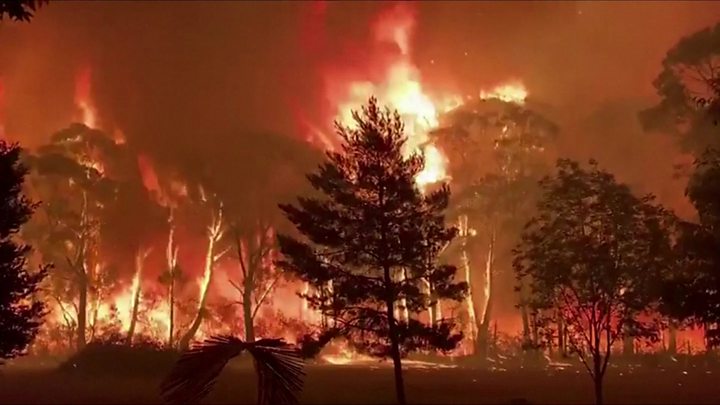
Simulated “misery index” in Australia on Dec. 17, 2019. (earth.nullschool.net)
Australia had its hottest day on record Dec. 17, with a nationally averaged temperature of 105.6 degrees (40.9), according to the country’s Bureau of Meteorology. This beats the old record of 104.5 degrees (40.3 Celsius) on Jan. 7, 2013.
However, it’s a record that may not stand for long — perhaps for just 24 hours, as forecasters anticipate it could be broken both Wednesday and Thursday eastern time, as a searing, early-season heat wave roasts the country.
“This hot air mass is so extensive that preliminary figures show that yesterday was the hottest day on record in Australia,” said BOM meteorologist Diana Eadie.
It’s highly unusual for a national temperature record to be broken, but to be broken on two to three straight days is even more rare.
[Australia braces for highest temperatures in recorded history amid blistering heat wave]
Numerous locations in inland Australia exceeded 115 degrees (44.8 Celsius) on Dec. 17, with even higher temperatures expected Wednesday. The hottest temperature ever recorded in Australia, which was 123 degrees (50.6 Celsius), set on Jan. 2, 1960, in Oodnadatta, may be in jeopardy during this event.

High temperatures Dec. 17, 2019, Australia's hottest day on record. (Bureau of Meteorology)
The heat is combining with drought conditions and burning wildfires to lead to severe to “extreme” fire danger in parts of Victoria, South Australia and New South Wales on Thursday local time. The extreme fire danger warning includes metropolitan Sydney, where the heat is ramping up.
The heat is forecast to peak Friday in Adelaide, where the forecast high temperature is 113 degrees (45 Celsius), as well as Melbourne, which is predicted to reach 109 degrees (43 Celsius).
The BOM is also forecasting that many locations will break monthly records for the hottest temperatures in December. In fact, some places in New South Wales could see their hottest temperature on record for any time of the year, particularly Saturday, according to BOM meteorologist Blair Trewin.
- Perth, in Western Australia, has already broken its all-time December record for the number of consecutive days (three) reaching or exceeding 104 degrees (40 Celsius).
- In Adelaide, the forecast calls for four straight days (through Friday) with high temperatures of 104 degrees or higher, according to BOM meteorologist Sarah Scully.
In New South Wales, which has been the state hit hardest with bush fires, parts of Sydney could reach 104 degrees amid smoky conditions Thursday, before temperatures retreat over the weekend.
In general, temperatures have been running between about 18 to 30 degrees above average in parts of the country, according to the BOM.
“Smoke will become a significant issue for populated areas in New South Wales and the Australian Capital Territory,” Eadie said. “This will combine with severe to extreme heat wave conditions to have a large impact on people’s health.”
Extreme heat is the number one weather-related killer in Australia, and smoke from ongoing bush fires has occasionally been so thick that visibility has deteriorated to below one mile in Sydney. Bush fire smoke can worsen asthma and other respiratory conditions, aggravate heart problems, and pose risks for the young and elderly alike.
Climate studies have shown clear and causal links between bush fires — as well as wildfires in the United States — and long-term global warming. Climate change helps escalate fire risks by drying out vegetation and making it more flammable, among other effects.
According to a new BOM report on the 2019 bush fires, spring 2019 brought the highest fire weather danger on record in Australia, as measured by the Forest Fire Danger Index, with “record high values observed in areas of all states and territories.”
Long-term climate trends in Australia show clear warming and an increase in extreme heat events. Last summer, for example, was the country’s hottest on record, and the meteorology bureau found that climate change exacerbated extreme heat events as well as droughts during the year.
Australia has warmed by just over 1.8 degrees (1 Celsius) since 1910, with most of the warming occurring since 1950. The BOM has found an increase in the frequency of extreme heat events and severity of drought conditions during this period, as well.
Nine of Australia’s top 10 warmest years on record have occurred since 2005, and 2019 is likely to join that list. Globally, 2019 is virtually assured to be the second-warmest year on record, according to NASA and the National Oceanic and Atmospheric Administration.
Australia is one of the most vulnerable major industrialized countries to climate change, particularly when it comes to extreme heat and drought conditions. However, the country is also a major exporter of coal, a greenhouse-gas-intensive energy source.
The heat and bush fires this spring and summer have put pressure on the pro-business and pro-coal Liberal government of Prime Minister Scott Morrison to take more aggressive climate action.
https://news.google.com/__i/rss/rd/articles/CBMigwFodHRwczovL3d3dy53YXNoaW5ndG9ucG9zdC5jb20vd2VhdGhlci8yMDE5LzEyLzE3L2F1c3RyYWxpYS1icmFjZXMtaGlnaGVzdC10ZW1wZXJhdHVyZXMtcmVjb3JkZWQtaGlzdG9yeS1hbWlkLWJsaXN0ZXJpbmctaGVhdC13YXZlL9IBkgFodHRwczovL3d3dy53YXNoaW5ndG9ucG9zdC5jb20vd2VhdGhlci8yMDE5LzEyLzE3L2F1c3RyYWxpYS1icmFjZXMtaGlnaGVzdC10ZW1wZXJhdHVyZXMtcmVjb3JkZWQtaGlzdG9yeS1hbWlkLWJsaXN0ZXJpbmctaGVhdC13YXZlLz9vdXRwdXRUeXBlPWFtcA?oc=5
2019-12-18 16:12:06Z
52780507823880








